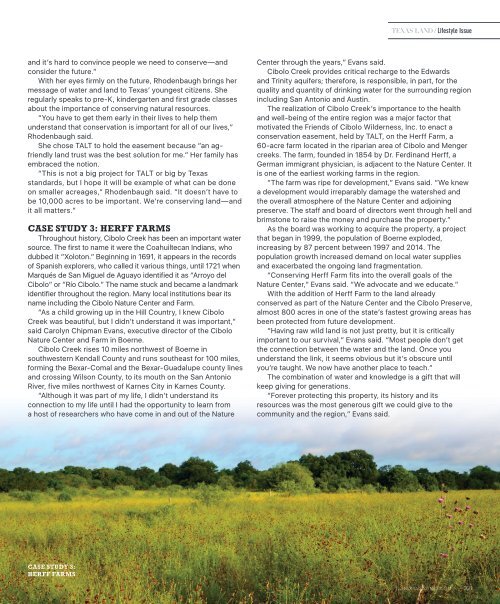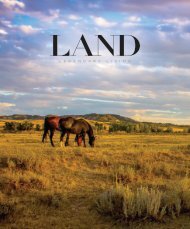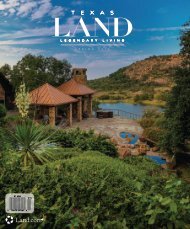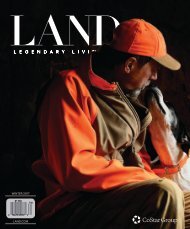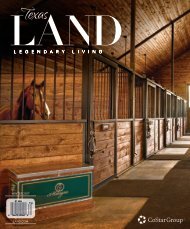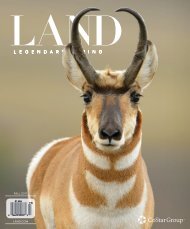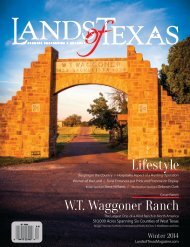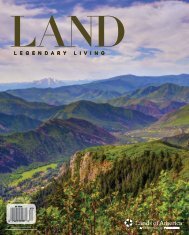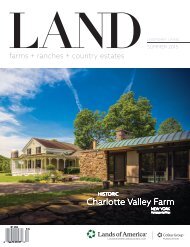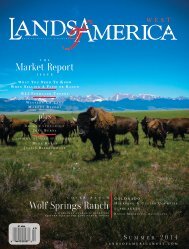Create successful ePaper yourself
Turn your PDF publications into a flip-book with our unique Google optimized e-Paper software.
TEXAS LAND / Lifestyle Issue<br />
and it’s hard to convince people we need to conserve—and<br />
consider the future.”<br />
With her eyes firmly on the future, Rhodenbaugh brings her<br />
message of water and land to Texas’ youngest citizens. She<br />
regularly speaks to pre-K, kindergarten and first grade classes<br />
about the importance of conserving natural resources.<br />
“You have to get them early in their lives to help them<br />
understand that conservation is important for all of our lives,”<br />
Rhodenbaugh said.<br />
She chose TALT to hold the easement because “an agfriendly<br />
land trust was the best solution for me.” Her family has<br />
embraced the notion.<br />
“This is not a big project for TALT or big by Texas<br />
standards, but I hope it will be example of what can be done<br />
on smaller acreages,” Rhodenbaugh said. “It doesn’t have to<br />
be 10,000 acres to be important. We’re conserving land—and<br />
it all matters.”<br />
CASE STUDY 3: HERFF FARMS<br />
Throughout history, Cibolo Creek has been an important water<br />
source. The first to name it were the Coahuiltecan Indians, who<br />
dubbed it “Xoloton.” Beginning in 1691, it appears in the records<br />
of Spanish explorers, who called it various things, until 1721 when<br />
Marqués de San Miguel de Aguayo identified it as “Arroyo del<br />
Cibolo” or “Río Cibolo.” The name stuck and became a landmark<br />
identifier throughout the region. Many local institutions bear its<br />
name including the Cibolo Nature Center and Farm.<br />
“As a child growing up in the Hill Country, I knew Cibolo<br />
Creek was beautiful, but I didn’t understand it was important,”<br />
said Carolyn Chipman Evans, executive director of the Cibolo<br />
Nature Center and Farm in Boerne.<br />
Cibolo Creek rises 10 miles northwest of Boerne in<br />
southwestern Kendall County and runs southeast for 100 miles,<br />
forming the Bexar-Comal and the Bexar-Guadalupe county lines<br />
and crossing Wilson County, to its mouth on the San Antonio<br />
River, five miles northwest of Karnes City in Karnes County.<br />
“Although it was part of my life, I didn’t understand its<br />
connection to my life until I had the opportunity to learn from<br />
a host of researchers who have come in and out of the Nature<br />
Center through the years,” Evans said.<br />
Cibolo Creek provides critical recharge to the Edwards<br />
and Trinity aquifers; therefore, is responsible, in part, for the<br />
quality and quantity of drinking water for the surrounding region<br />
including San Antonio and Austin.<br />
The realization of Cibolo Creek’s importance to the health<br />
and well-being of the entire region was a major factor that<br />
motivated the Friends of Cibolo Wilderness, Inc. to enact a<br />
conservation easement, held by TALT, on the Herff Farm, a<br />
60-acre farm located in the riparian area of Cibolo and Menger<br />
creeks. The farm, founded in 1854 by Dr. Ferdinand Herff, a<br />
German immigrant physician, is adjacent to the Nature Center. It<br />
is one of the earliest working farms in the region.<br />
“The farm was ripe for development,” Evans said. “We knew<br />
a development would irreparably damage the watershed and<br />
the overall atmosphere of the Nature Center and adjoining<br />
preserve. The staff and board of directors went through hell and<br />
brimstone to raise the money and purchase the property.”<br />
As the board was working to acquire the property, a project<br />
that began in 1999, the population of Boerne exploded,<br />
increasing by 87 percent between 1997 and 2014. The<br />
population growth increased demand on local water supplies<br />
and exacerbated the ongoing land fragmentation.<br />
“Conserving Herff Farm fits into the overall goals of the<br />
Nature Center,” Evans said. “We advocate and we educate.”<br />
With the addition of Herff Farm to the land already<br />
conserved as part of the Nature Center and the Cibolo Preserve,<br />
almost 800 acres in one of the state’s fastest growing areas has<br />
been protected from future development.<br />
“Having raw wild land is not just pretty, but it is critically<br />
important to our survival,” Evans said. “Most people don’t get<br />
the connection between the water and the land. Once you<br />
understand the link, it seems obvious but it’s obscure until<br />
you’re taught. We now have another place to teach.”<br />
The combination of water and knowledge is a gift that will<br />
keep giving for generations.<br />
“Forever protecting this property, its history and its<br />
resources was the most generous gift we could give to the<br />
community and the region,” Evans said.<br />
CASE STUDY 3:<br />
HERFF FARMS<br />
LANDMAGAZINES.COM<br />
101


